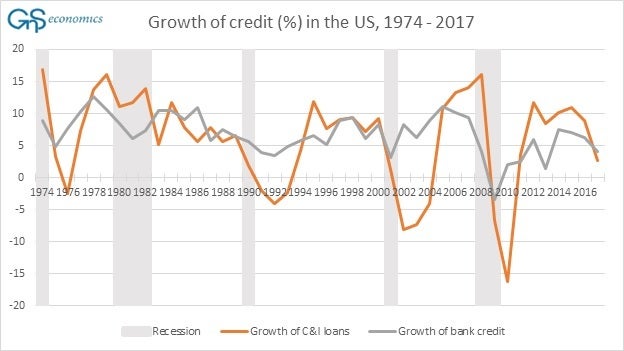Prediction, not narration, is the real test of our understanding of the world.
- Nassim Nicholas Taleb, The Black Swan
The year 2018 has started with a bang. The stock markets have rallied to new records. The declining volatility, the time without larger corrections and the streak of the upward momentum of the asset prices have all set records. At the same time, the warnings of high market valuations have grown louder, and for a good reason. According to some metrics, this is the most overbought market ever.
The combination of the relentless upward-march of the asset prices with record-low volatility is a risk not generally understood. The economist tend combine different metrics like leading indicators and purchasers’ managers indexes, to build up their forecasts for the economic development in the nearest future. Although these naturally matter, they ignore the effects that financial shocks can have on the economy. This is somewhat confusing as the crash of 2008, which started the Great Recession, clearly revealed the role that a financial shock can have. Currently, the risks for a financial shock and a sudden reversal of economic growth are all plainly visible.
The principles of economic forecasting and its limitations
The models that economists use to construct their forecasts are usually based on real economic variables, like investments and consumption and on the so called soft indicators, like consumer sentiment. Although some financial market data has been included, previous forecasting models, based on the mathematically helpful but otherwise questionable assumption of “general equilibrium”, usually left out the financial sector completely. This is likely to be the main reason why the crash 2008 was so largely missed by economic forecasters.
Currently, the problem is that the financial information is badly distorted. As we have repeatedly noted (see, e.g., this and this), the artificial liquidity from the central bank bond purchase programs has twisted the prices of almost every asset class. Therefore, the financial information about the bond and stock markets cannot be trusted to give the accurate look to the future economic prospects. Actually, the artificially propped asset prices constitute a risk for an asset market crash with serious repercussions for the real economy.
The risks are ample
In addition to markets crashing under their own weight, there are three developments, which can currently be seen leading to a sudden financial shock:
1. The over-indebtedness in China,
2. The tapering and quantitative tightening of the central banks, and
3. The diminishing momentum of the US economy.
We have written several pieces on the global role and risks of China (see, e.g., this, this and this). The principle is that China has supported the global economy by a massive and unsustainable credit stimulus enacted through its centrally controlled financial sector. My latest take on the risks and the aftermath of the central bank tightening can be found here. The main point is that the tightening by both China and the central banks may lead to a sudden reversal in the over-bought asset markets.
The business-friendly policy of president Trump has given a prominent boost for the US economy. A reasonable argument can be made that without Trump, the US might already be in recession. Many real economic and soft indicators, like domestic investments and business sentiments are now at high levels indicating a rising economic momentum. However, something is not right in the US economy.
I, among others, have been waiting for the recovery in the expansion of credit in the US in the wake of revigorated business investing. This has not happened. The Figure below presents the annual growth rates of the total bank credit and commercial and industrial loans. Currently, both are in a clear decline. It is notable that whenever their growth rates have simultaneously declined rapidly (the annual decline of combined growth of more than 5%), the economy has either already been in a recession or the recession has started in the following year. In 2017, their combined growth rate fell by 8.4 percent. In addition, the credit impulse of the US economy has continued to decline. These are rather clear recessionary signals (see also Q-review 2/2017).

A historical analog from the 1920’s shows what can happen if the real economy gives way under an over-bought asset market. When the US economy and corporate profits turned the corner after a massive asset price boom in early 1929, the stock market crash that started the Great Depression was only a few months away. Whether we are facing a similar situation now remains to be seen, but caution is warranted.
Economic forecasts may again be blind on what is to become
In the current artificially propped market environment, the economic forecasts based on real economic, soft and financial indicators may fail massively. The fact that the central bankers and the government of China are driving the global economy is such a serious problem for forecasting because this means that the global economy is dictated by a heterogeneous group of policy makers. Standard forecasting models do not apply and information has to be gathered from cryptic political messages and from those few economic variables that still are likely to correctly reflect the state of the economy, like debt and market valuations, often neglected in economic models.
If our forecast on the impending crisis provers to be correct, which we naturally strongly believe, there will be a massive shock to many businesses and households but also to economic sciences. If another major crisis is able to strike the economists and the world economy within only 10+ years, then we face a serious failure of modern macroeconomics. Criticism by renowned economists (see this and this) has been bypassed thus far, but we may very well be forced to swallow it.
In any case, time of the all-powerful central banks is ending. Let us hope that economists have the wisdom and courage to embrace the change. Otherwise, even more economic calamity will follow.
